XXX . XXX 4%zero null 0 1 2 Traffic Light Control
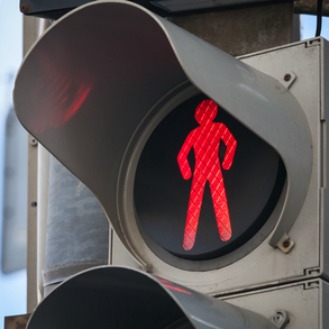
What to do with this activity?
You can play the traffic lights game with just two people or with several. It works better outdoors, but play it indoors if you have enough space.
Here's how to play the game:
1. One person calls out the instructions and pretends to direct traffic. The others follow the instructions.
2. There's a choice of three instructions, all relating to the colour of traffic lights - either "red", "green" or "amber".
3. If "red" is called then everyone must stand very still and silent.
4. If "green" is called then everyone moves around quite fast.
5. If "amber" is called then everyone moves around in slow motion.
6. Take it in turns to direct the traffic and shout the instructions.
When you cross a road, show your child real traffic lights and tell them that they have to stop at red lights.
Traffic Light Control
Introduction
Traffic Lights are used to control the vehicular traffic. In the modern era, everyone has different types of vehicles resulting in rise to the numbers of vehicles. That’s why traffic lights are mandatory to avoid the traffic jams and accidents. There are three lights in the traffic signal, having different message for the drivers. Red light (upper one) asks the driver to yield at the intersection, green light (last one) gives the driver free license to drive through the intersection whereas the yellow light (middle one) alerts the driver to wait if the next light is red one or get ready to go / turn the engine ON if the green light is next.
Traffic light has proved to be an amazing way to stop the vehicular collisions and control the traffic jams in today’s modern era where everyone owns the different types of vehicles.

Project Proposal:
As we all know, the name of the project is “Traffic Light Control”. The fundamental idea of this simple electronic project is to control the traffic. It can be used to avoid the vehicular collisions and traffic jams. This project is just a one-way traffic controller, although it can be further modified as well. Project will work in a way, it provides the instruction to the driver whether to drive through the intersection or yield at the intersection.
Control Lights indication:
There are three control lights or signals, which will provide the instruction to the driver.
- RED light – instructs the driver to STOP at the intersection.
- YELLOW light – instructs the driver to WAIT (If red light is next) or GET READY (if green light is next)
- GREEN light – instructs the driver to GO through the intersection.
Components Requirements:
There are quite a few components, which we will be using to make our Traffic Light Control System. Following is the list of the components.
- 9V Battery (Input Battery)
- 100K, 22K and 330 ohm resistors
- 1µF, 10µF and 2.2mF capacitors
- Six 1N4148 diodes
- 555 timer IC (As a pulse generator)
- 4017 IC counter (Main IC of the circuit)
- 1M Potentiometer (Controls the timing of pulse generated by 555 timer)
- Red, yellow and green LEDs. (Output)
Circuit Diagram of Traffic Light Control mini Project
Click image to enlarge
Working Principle:
This traffic light is made with the help of counter IC, which is mainly used for Sequential Circuits. We can also call it as Sequential Traffic Lights. Sequential Circuits are used to count the numbers in the series.
Coming to the working principle of Traffic Lights, the main IC is 4017 counter IC which is used to glow the Red, yellow and green LED respectively. 555 timer acts as a pulse generator providing an input to the 4017 counter IC. Timing of glow of certain lights totally depends upon the 555 timer’s pulse, which we can control via the Potentiometer so if you want to change the time of glow, you can do so by varying the potentiometer, having the responsibility for the timing. LEDs are not connected directly with 4017 counter, as the lights won’t be stable. We have used the combination of 1N4148 diodes and the LEDs in order to get the appropriate output. Main drawback of this circuit is that you can never have an exact timing with this, however you will have best estimated.
TRAFFIC LIGHTS Circuit
clever circuit using two 555's to produce a set of traffic lights for a model layout.
The animation shows the lighting sequence and this follows the Australian-standard. The red LED has an equal on-off period and when it is off, the first 555 delivers power to the second 555. This illuminates the Green LED and then the second 555 changes state to turn off the Green LED and turn on the Orange LED for a short period of time before the first 555 changes state to turn off the second 555 and turn on the red LED. A supply voltage of 9v to 12v is needed because the second 555 receives a supply of about 2v less than rail. This circuit also shows how to connect LEDs high and low to a 555 and also turn off the 555 by controlling the supply to pin 8. Connecting the LEDs high and low to pin 3 will not work and since pin 7 is in phase with pin 3, it can be used to advantage in this design.

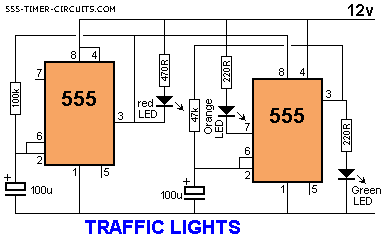
The animation shows the lighting sequence and this follows the Australian-standard. The red LED has an equal on-off period and when it is off, the first 555 delivers power to the second 555. This illuminates the Green LED and then the second 555 changes state to turn off the Green LED and turn on the Orange LED for a short period of time before the first 555 changes state to turn off the second 555 and turn on the red LED. A supply voltage of 9v to 12v is needed because the second 555 receives a supply of about 2v less than rail. This circuit also shows how to connect LEDs high and low to a 555 and also turn off the 555 by controlling the supply to pin 8. Connecting the LEDs high and low to pin 3 will not work and since pin 7 is in phase with pin 3, it can be used to advantage in this design.





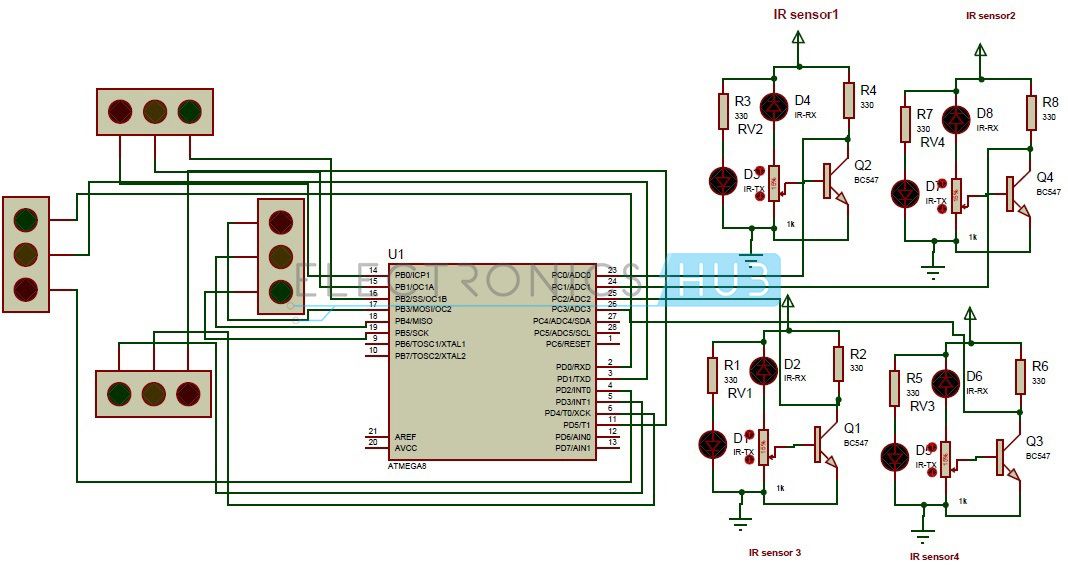
density Based Traffic Lights System Circuit Diagram
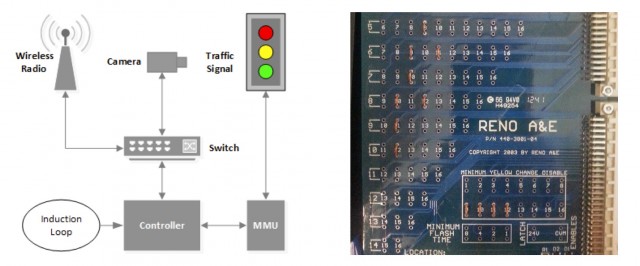
Open wireless and default passwords make controlling a city's intersections trivial.

A typical intersection configuration.
the researchers describe how they very simply and very quickly seized control of an entire system of almost 100 intersections in an unnamed Michigan city from a single ingress point.
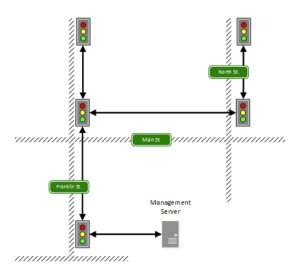
Enlarge / Nodes in the traffic light network are connected in a tree-topology IP network, all on the same subnet.
The exercise was conducted on actual stoplights deployed at live intersections, As is typical in large urban areas, the traffic lights in the subject city are networked in a tree-type topology, allowing them to pass information to and receive instruction from a central management point. The network is IP-based, with all the nodes (intersections and management computers) on a single subnet. In order to save on installation costs and increase flexibility, the traffic light system uses wireless radios rather than dedicated physical networking links for its communication infrastructure—and that’s the hole the research team exploited.
Wireless security? What's that?
The systems in question use a combination of 5.8GHz and 900MHz radios, depending on the conditions at each intersection (two intersections with a good line-of-sight to each other use 5.8GHz because of the higher data rate, for example, while two intersections separated by obstructions would use 900MHz). The 900MHz links use "a proprietary protocol with frequency hopping spread-spectrum (FHSS)," but the 5.8GHz version of the proprietary protocol isn’t terribly different from 802.11n.
In fact, using unmodified laptops and smartphones, the team was able to see each intersection’s broadcast SSID, though they were unable to join the networks due to the protocol differences. The paper notes that researchers could have reverse-engineered the protocol to connect but instead chose to simply use the same type of custom radio for the project as the intersections use. Lest you think that’s cheating, the paper explains the decision like this:
We chose to circumvent this issue and use the same model radio that was deployed in the studied network for our attack. While these radios are not usually sold to the public, previous work has shown social engineering to be effective in obtaining radio hardwareOnce the network is accessed at a single point, the attacker can send commands to any intersection on the network. This means an adversary need only attack the weakest link in the system.
The 5.8GHz network has no password and uses no encryption; with a proper radio in hand, joining is trivial.
Smash box
After gaining access, the next step was to be able to communicate with the controllers that operate each intersection. This was made easy by the fact that in this system, the control boxes run VxWorks 5.5, a version which by default gets built from source with a debug port left accessible for testing. The research team quickly discovered that the debug port was open on the live controllers and could directly "read and write arbitrary memory locations, kill tasks, and even reboot the device."
Debug access to the system also let the researchers look at how the controller communicates to its attached devices—the traffic lights and intersection cameras. They quickly discovered that the control system’s communication was totally non-obfuscated and easy to understand—and easy to subvert:
By sniffing packets sent between the controller and this program, we discovered that communication to the controller is not encrypted, requires no authentication, and is replyable. Using this information, we were then able to reverse engineer parts of the communication structure. Various command packets only differ in the last byte, allowing an attacker to easily determine remaining commands once one has been discovered. We created a program that allows a user to activate any button on the controller and then displays the results to the user. We also created a library of commands which enable scriptable attacks. We tested this code in the field and were able to access the controller remotely.
Once total access to a controller and its commands was gained, that was it—at that point, the team had full control over every intersection in the entire network. They could change lights at will and even control each intersection’s cameras. The paper lays out several potential activities that an attacker could engage in, including connecting from a moving vehicle and making all lights along the attacker’s path green, or purposefully snarling traffic to aid in the attacker’s escape after a crime.
More worrying is the ability of an attacker to engage in a type of denial-of-service attack on controlled intersections by triggering each intersection’s malfunction management unit, which would put the lights into a failure mode—like all directions blinking red—until physically reset. This would, according to the paper, let "an adversary… disable traffic lights faster than technicians can be sent to repair them."
Mitigation
The paper closes by pointing out a number of ways in which the gaping security holes could be easily closed. Chief among the recommendations is some kind of wireless security; the paper points out that the 5.8GHz systems support WPA2 encryption, and enabling it is trivial. The 900MHz systems are more secure by virtue of not using a frequency band easily accessible by consumer laptops and smartphones, but they also support the older WEP and WPA wireless encryption standards.
But a layered defense is best, and as such the paper also recommends stricter controls over the traffic systems’ IP networks—fire walling devices and strictly controlling the type of network traffic allowed.
Further, though many of the components in the network support some kind of username and password authentication scheme, the report ominously points out that "all of the devices in the deployment we studied used the default credentials that came built into the device." Doing some basic housekeeping and changing the credentials on the VxWorks intersection controllers and the wireless network components would go a long way toward frustrating attacks.
++++++++++++++++++++++++++++++++++++++++++++++++++++++++++++++++++++++++++++
LUDO GAME ON COMBINE TO TRAFFIC LIGHT
++++++++++++++++++++++++++++++++++++++++++++++++++++++++++++++++++++++++++++

Tidak ada komentar:
Posting Komentar